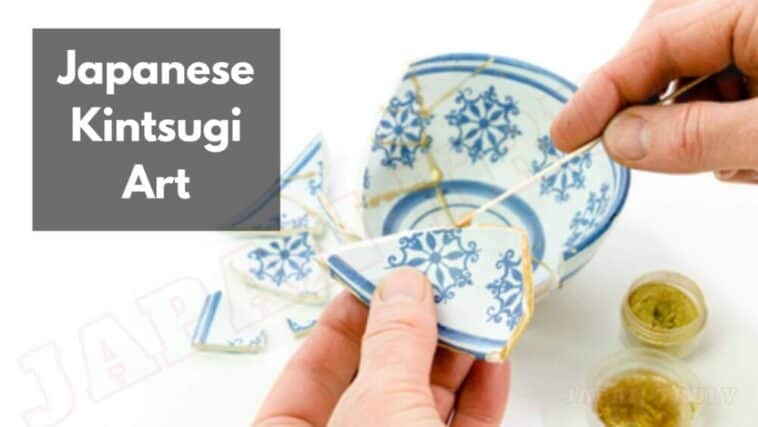Here’s everything I learnt about Japanese Kintsugi Art and its significance.
Discover Kintsugi, the poignant Japanese art of repairing broken pottery with gold, which celebrates imperfections and breathes new life into damaged objects.
This ancient technique is more than mere restoration—it’s a philosophical expression of resilience, rebirth, and beauty in imperfection, deeply embedded in the Japanese aesthetic consciousness.
Here is everything you need to know about this ancient art form:
Page Contents
What is Japanese Kintsugi Art?

Also known as Kintsukuroi or Golden repair or Golden joinery, Kintsugi is the art of repairing broken or cracked vessels by covering the cracks using lacquer and dusting them carefully with some precious metal like shiny gold powder, liquid gold, silver and so on.
Japanese natives believe the golden cracks make the art more aesthetically pleasing, significant, valuable and precious.
The process involves connecting pieces and giving them its own polished, authentic and attractive charm. You can apply the teachings of this art to real life by not discarding any items and believe that its flaws have the potential to be beneficial.
The ORIGIN Japanese Kintsugi Art:
Although Kintsugi was a new art form, the art of attaching broken pieces of urushi lacquer which is extracted from the Rhus verniciflua plant has been in both japan and China for a very long time.
In the 15th Century, after shattering his favorite cup of tea, Japanese Shogun Ashikaga Yoshimasa, sent it to China to be fixed but the craftsmen mended it with unattractive and displeasing staples.
The cup seemed to be unrepairable, but the Shogun asked his Japanese craftsmen to step in and use an aesthetic approach. The Kintsugi art was first seen in Ancient Greece but was customary in Japan.
They decide to transform the teacup into a gem by sealing the cracks with powdered gold and lacquered resin.
The Shogun was over the moon to have his favorite teacup back, more beautiful than before. This incident laid the groundwork for a completely new form of art.
The PHILOSOPHY Japanese Kintsugi Art
The basic idea behind Kintsugi is to refine the scars of the discarded and broken items and give it a new lease of life.
Spiritual Teachings of Mushin
The Kintsugi significance and meaning are related to a Japanese philosophy called Mushin that covers the principles of embracing impermanence, non-attachment and fate to which all humans are subjected to the same bangs, cracks and shattering as ceramics.
Christy Bartlett found a correlation between this philosophy and Kintsugi and wrote about it in her book called Flickwerk: The Aesthetics of Mended Japanese Ceramics.
Teachings of Wabi-sabi
Wabi originally referred to the extension of simple and rustic things, loneliness of life in nature. While sabi denotes nostalgia, beauty of time, tranquility and old age. Kintsugi is more than a simple mending technique. It is an aesthetic, a way of life and thinking which the Japanese call Wabi-Sabi.
This is based on the acceptance of imperfection and seeing beauty in it. Both Kintsugi and Wabi-sabi teach us to accept the good and bad aspects of ourselves , therefore it is an ideal path to enlightenment.
Teachings of Kansha:
Kansha is all about letting go of ego and reframing situations so that your brain is rewired to see good rather than bad. It also practices gratitude for accepting both which is a mission for us to become better, appreciative and resilient people.
Teachings of Eiyoshoku:
It encourages keeping your mind and body healthy and well nourished which is the basic foundation for a good mentality.Self-care involves nourishing oneself from the inside and out.
Teachings of Gaman
Gaman is all about the capacity to be calm, and urges one to concentrate on inner ability and power.
It can be practiced with visualization, meditation and concentration.Rather than focusing on the bad, we need to look at problems as a chance to grow.
Teachings of Yuimara
The Kintsugi art also teaches us the value of appreciating people and relationships and unity which is called Yuimaru which means, ‘the spirit of cooperation.’
Types Or Techniques Of Kintsugi Art:
Kintsugi is divided into three styles namely: crack, joint-call, piece and staple repair method.
With the “crack” method, objects that have been repaired by cracking are given a light coat of lacquer or gold dust or resin with minimal overlap from any mission items. This is the most common method which has given incredible and shimmering results.
In the piece technique, the craftsman uses gold or lacquer to fill any missing part.
You can also restore the parts with the joint call method which involves using metal lacquer to attach broken pieces together. This creates a patchwork style of mending.
The staple repair method involves drilling tiny holes on both sides of a fracture and bending metal staples to hold the pieces together.
Kintsugi In The Modern World:
There is no denying the fact that this art form has grabbed the attention of other cultures in different parts of the world. It is celebrated globally and has even reached the Metropolitan Museum in New York.
Contemporary designers, exhibitions and artists have incorporated this technique brilliantly. New York designer George Inaki Root, created a beautiful jewelry line Kintsungi with the same techniques.
British artist Karen Lamonte used the art form as an inspiration for her fashion designs. In 2020,Victor Solomon was inspired by the Kintsugi practices to repair a broken basketball court in Los Angeles.
In today’s world, the art form has become a metaphor for reconstruction after painful or difficult events like the loss of a loved one.
They have become an opportunity to find in the Japanese art of fixing and mending together ceramics using a golden form of serenity and comfort.
How To Apply Kintsugi Art Techniques In Your Life?
Transforming broken things into something beautiful is a wonderful art we need to apply to our own personal lives. Repairing a broken bowl or plate and using golden filling makes the piece more valuable and appealing.
Why not transform our bad past experiences and emotional wounds and turn them to our advantage? Don’t be fooled.
Kintsugi can teach us in many ways to be strong and resilient to face past, present or future suffering. Some life lessons we can draw from this ancient art are:
- The spirit of Kintsugi is a practice of self-love and forgiveness. You must first learn to forgive yourself and accept your cracks before loving and forgiving another person.
- Once we change our mindset, we become a more refined and beautiful version of ourselves.
- Your deepest wounds, hardest challenges and greatest fears are the most admirable and beautiful parts of you.
- Kintsugi promotes learning and we must be committed to these practices and teachings every single day.
- It also encourages us to live humbly and eliminate our needs and wants on materialism.
All in all, the kintsugi approach highlights the beauty of what we do have, accepting all our flaws and cracks.
Learning to accept our flaws will lead to a deeper sense of peace, calm and fulfillment.The philosophy of Kintsugi art has the ability to improve the life of modern society.
Japanese Kintsugi Art: FAQs
What does Kintsugi mean?
Kintsugi translates to golden joinery and Kintsukuroi translates to golden repair.
Why do Japanese repair broken objects?
They believe in its philosophy of honoring both good and bad experiences in life. By focusing on the cracks in a ceramic piece, there is no attempt to conceal the damage but only illuminate its beauty.
How much does the Kintsugi artwork cost?
The prices for the Kintsugi art depends on certain factors such a sthe length, break lines, value of the ceramic piece and so on. It may roughly cost between 5.000-10,000 yen or more.
Can Kintsugi art be done on glass?
Technically, it can be applied on glass but the transparency and profile of the crack can be seen on the glass and cause an undesirable effect.
What can it teach you about being flawed?
There is beauty in every imperfection, aging is natural, breaks can heal, scars are experiences of life.
Conclusion:
If this art form is intriguing and has convinced you to learn more about it, then you will find numerous Kintsugi studios in Japan offering training courses and workshops.
It is very challenging and requires a great level of patience, skills and important materials. If you prefer online learning, then some studios have that option as well. To start with, you will find many easy tutorials on YouTube which you can see for some interesting DIY projects.
So do not worry! It is never too late to enroll yourself and master this spectacular art form.





